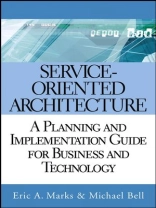Praise for Service-Oriented Architecture
‚This book provides a superb overview of the SOA topic. Marksand Bell provide practical guidance across the entire SOA lifecycle-from business imperatives and motivations to thepost-deployment business and technical metrics to consider. Withthis book, Marks and Bell demonstrate a unique ability to take thecomplex dynamics of SOA, and through an eloquent set of metaphors, models, and principles, provide an understandable and insightfulhow-to manual for both technical and business executives. This willbecome a required handbook for any organization implementing SOA.‘
–Dan Bertrand, Enterprise Technology Officer & EDSFellow, EDS Corporation
‚A fundamental breakthrough in the business and technologyperspectives of SOA-this book belongs in every software developer, architect, and IT executive library. Marks and Bell demonstrate acreative and practical approach to building complex, service-oriented systems. I especially liked the hands-onperspective brought to multiple aspects of SOA. A must-have guidein the technology turbulence of the future.‘
–Ariel Aloni, Chief Technology Officer, Sun Gard Data Management Solutions
‚This outstanding text gets straight to the heart of the matter, cutting through the hyperbole and discussing how to drive realbusiness value through SOA. It will certainly impact my behavior, our governance models, and, subsequently, the successful businessoutcomes we derive as we continue to embrace SOA. A must-read forbattle-scarred SOA veterans and fledgling architects alike.‘
–Christopher Crowhurst, Vice President and Chief Architect, Thomson Learning
‚Too often, SOA has been perceived as ‚all about thetechnology‘-standards, technology stacks, operational monitoring, and the like. In this book, Marks and Bell expand beyond thetechnology to provide a refreshing business-driven perspective to SOA, connecting the dots between business requirements, architecture, and development and operations, and overlaying theseperspectives with tried-and-true governance techniques to keep SOAinitiatives on track. A must-read for those leading the charge toadopt SOA within their enterprise.‘
–Brent Carlson, Chief Technology Officer, Logic Library andcoauthor of San Francisco Design Patterns: Blueprints for Business Software
‚Marks and Bell have captured a wealth of practical experienceand lessons learned in what has become the hottest topic insoftware development. In this book, they explain in detail whatworks and what does not, from procedural issues to technicalchallenges. This book is an invaluable reference for organizationsseeking the benefits of SOAs.‘
–Dr. Jeffrey S. Poulin, System Architect, Lockheed Martin andauthor of Measuring Software Reuse: Principles, Practices, and Economic Models
‚One of the last things companies often consider whenimplementing a business solution such as SOA is the impact onpeople. Marks and Bell provide an in-depth look at ‚what has tochange‘ from a process standpoint to make any SOA implementation asuccess. A great read for those considering to embark on anenterprise SOA and looking for the right mix of people, process, and products.‘
–Alan Himler, Vice President of Product Management and Marketing, Logic Library
SOA is a complex topic and a complex organizationalgoal
Service-Oriented Architecture: A Planning and Implementation Guide for Business and Technology shows you how to plan, implement, and achieve SOA value through its prescriptive approach, joining the business and strategic perspective to the technical andarchitectural perspective.
Applicable to all industries, technology platforms, andoperating environments, this innovative book provides you with theessential strategies to drive greater value from your SOA andrealize your business goals.
Inhaltsverzeichnis
Preface.
Chapter 1: Introduction to the SOA Business Model.
Elements of an SOA.
Conceptual SOA Vision.
Services.
Enabling Technology.
SOA Governance and Policies.
Metrics.
Organizational and Behavioral Change.
SOA: Behavior and Culture.
New SOA Conceptual, Architectural, and Organizational Models.
SOA: Its Time Has Come.
SOA: Evolved Enterprise Integration.
SOA Means ‚Service-Oriented Agility‘.
Service-Oriented Business: SOA = Business-Oriented Architecture.
Characteristics of a Zero-Integration Enterprise.
What Are the Challenges of SOA?
Chapter 2: General Model for Services.
SOA Is All About Services.
Services Address Persistent Challenges and Present New Opportunities.
General Model of Services.
Services in an SOA Context.
Service Lifecycle.
Summary.
Chapter 3: SOA Business Modeling.
SOA Business Iteration Model.
SOA Business Modeling.
Identify Major Business Challenges: Imperative Analysis.
Focusing Your SOA Efforts.
Summary.
Chapter 4: Services Identification, Analysis, and Design.
Begin with Candidate Business Services.
Business Process Analysis.
Core Entity Analysis.
Opportunistic Approach via Already-Budged Projects.
Business and Domain Expertise.
Preexisting Services.
Existing Business Applications.
Top-Down or Bottom-Up? Both, Then Iterate.
Focus on Candidate Business Services.
Service Analysis and Design.
Candidate Service Analysis.
Service Design.
Bottom-Up Design and Analysis Approach.
Summary.
Chapter 5: SOA Technology and Services Integration Model.
Service Integration Model Framework.
Service Integration Generic Notation.
Service Integration Principles.
Service Integration Design.
Service Integration Modeling.
Service Product Mapping Component: Integration Product Mapping Strategy.
Summary.
Chapter 6: Fundamentals of SOA Asset Reuse: Service Reusability Model.
Major Influences on Service Reusability.
Service Reuse Model.
Service Reusability Strategy.
Service Construction.
Service Integration.
Service Management.
Summary.
Chapter 7: SOA Governance, Organization, and Behavior.
Architecture’s Role in an SOA.
Dynamic Architecture versus Static Architecture.
SOA: Spatial and Temporal Challenges.
SOA Governance Overview.
Organization of Governance.
What Does SOA Governance Do?
SOA Governance Organizational Model.
SOA Governance Processes.
Closed Loop SOA Governance.
What Is the SOA Governance Process?
SOA Policies: Where SOA Governance Gets Real.
SOA Governance Implementation and Integration.
Enabling Technology of SOA Governance.
SOA Behavioral Model: Beyond SOA Governance.
Summary.
Chapter 8: Architecture Organization Model.
When Should Enterprise Architecture Be Reviewed?
Key Questions.
SOA-Driven Enterprise Architecture Model.
Business Requirements.
Technological Requirements.
Architecture Disciplines.
Architecture Practices.
Architecture Roles.
Architecture Role Models.
Positioning of Architecture Organizations: An SOA Perspective.
Architecture Organizational Management Structure.
Summary.
Chapter 9: SOA Business Case and Return on Investment Model.
Achieving SOA Value.
SOA Value Considerations.
SOA Value Points.
Big Hairy Audacious Value.
SOA Process.
Process Approach to SOA ROI.
Exploring the SOA Value Model.
SOA ROI Threshold Model.
Targeting ROI with SOA Initiatives.
SOA and Services Reuse.
SOA Metrics and SOA Scorecards.
Summary.
Index.
Über den Autor
ERIC A. MARKS is President and CEO of Agile Path Corporation,
a service-oriented architecture (SOA) and Web services solutions
firm. He is a software and technology services veteran with
eighteen years of experience with firms including
Pricewaterhouse Coopers, Cambridge Technology Partners, Novell,
Electronic Data Systems, Stream Serve, Ontos, and Square D
Company/Schneider Electric. A business author and frequent speaker
on various IT topics, he serves on the Advisory Board of Directors
for Logic Library, a leading software asset reuse firm. He lectures
at Syracuse University’s nationally recognized School of
Information Studies and is a regular columnist for Computerworld
online, Managing Automation magazine, and the industry portal
Search Web Services.com.
MICHAEL BELL is the founder of Methodologies Corporation,
a service-oriented architecture modeling firm based in New Jersey.
He is a software, modeling, and architecture strategist veteran
with twenty years of experience designing, architecting, and
building high-volume, real-time trading systems for Wall Street
brokerage institutions, investment banking, credit card, and
insurance firms. These include institutions such as JPMorgan,
Chase, Citibank, American Express, and UBS Paine Webber.












